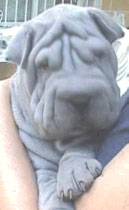Shar-Pei Recurrent Fever Syndrome
Also called swollen hock syndrome, Shar-Pei auto-inflammatory disease (SPAID), or familial Shar-Pei fever syndrome (FSF).
It would seem the Chinese Shar-Pei might have enough issues to contend with, given its potential for wrinkle-related skin and eyelid issues, but there is a special syndrome that every Shar-Pei owner needs to be familiar with: Recurrent Fever Syndrome.

As the name implies, the syndrome is characterized by fevers that seem to arise out of nowhere, run their course, and may or may not be responsive to anti-inflammatory medications.
The dog will feel bad during the fever episodes: listless and without appetite. Fevers typically last 12 to 36 hours and can go as high as 107ºF. Often the dog’s ankles (hocks) become swollen during these episodes. It is normal for a Shar-Pei to have a large skin fold around the ankle called a sock; the swelling that occurs during the fever is different and only lasts during the fever. The muzzle may also swell and become painful, and sometimes there is some associated nausea or diarrhea. It is important to learn how to take your dog’s temperature so you can monitor the situation.
A fever of 106ºF is a medical emergency. It is good practice to know how to take your dog’s temperature and is especially important if your Shar-Pei seems listless. Normal canine body temperature is 100-102ºF.
The fevers are unpleasant and can be dangerous if the fever rises to 106ºF but what makes this syndrome a serious problem is the accompanying kidney damage. An abnormal protein called amyloid is laid down in the kidney, destroying the kidney’s ability to filter protein. The valuable blood proteins are thus lost in urine along with waste chemicals. The dog becomes thin from the loss of body proteins, develops a propensity to throw abnormal blood clots throughout the body (from urinating out the proteins that would normally prevent this), and high blood pressure results.
All Shar-Pei should be regularly screened for urinary protein loss with a urinalysis. Red flags include urinary protein and dilute urine (specific gravity less than 1.020).
Why This Happens: Wrinkles Gone Wrong
The characteristic skin wrinkles that make the Shar-Pei what it is are caused by excessive production of hyaluronan. Hyaluronan is a structural protein in everyone’s skin but a mutation in the Shar-Pei leads to multiple copies of the genes regulating the production of hyaluronan. The result is a whole lot of extra hyaluronan puffing up the skin and creating all the wrinkles that characterize this breed.
All Shar-Pei have this mutation; without this mutation, the dog cannot really be a Shar-Pei but not all Shar-Peis have this mutation in the same way. Some have a mutation that leads to variable qualities of hyaluronan. In other words, not all the hyaluronan produced is of a healthy quality. Poor quality hyaluronan breaks down rapidly in a process that generates inflammation which, in turn, creates fever and damages organs. The mutation that creates all this poor-quality hyaluranan is often called the meat mouth mutation.
It might seem that you could simply look at a Shar-Pei’s face to determine if the dog is a candidate for fever syndrome but the situation is more complicated.

How do I Know if my Shar-Pei Has the Syndrome?
A fever can develop in a Shar-Pei from a wound or other source of infection, just as it can in any other breed of dog. Some effort should be made to find another source of the fever and this generally requires a complete physical examination and some blood testing.
As for screening tests, there is a genetic test available at Cornell University. The mutated genetic variant that creates the meat mouth appearance is typically in multiple copies within an affected Shar-Pei. The more copies the dog has, the more reactive the inflammation. The genetic test determines the number of mutated copies present and reports the “copy number variant.” The higher this number, the more trouble for the dog. In the absence of a test, a diagnosis is made based on the clinical findings. One episode of fever is enough to make the diagnosis. Fevers classically begin before 18 months but can begin at any age.
The test requires a blood sample and a six-page information form filled out by both the owner and the veterinary professional drawing the blood. A microchip number or tattoo is required to confirm the identity of the patient. Learn more about testing.
Though testing had been temporarily suspended as of August 21st, 2020, it seems that Cornell’s latest information says SPAID testing has been revived as of December 15, 2022.
Treatment
During a fever episode, anti-inflammatory medications provided by your veterinarian can be used to control high fevers. Pain medication is often needed to control the discomfort during the episode. The real challenge, however, is to prevent kidney damage in the long term. A dog can have substantial kidney damage before the first fever episode even happens therefore, it is important to begin therapy after the first episode and to regularly screen for urinary protein loss in any Shar-Pei whether fevers have occurred or not.
The medication central to preventing amyloid deposition in the kidney is colchicine.
Cell division, a process more scientifically known as mitosis, requires microscopic protein fibers acting like structural cables to pull dividing cells apart. These cables are called mitotic spindles, and colchicine interferes with their formation. The ability of colchicine to interfere with this sort of structural protein formation has led to its use in abnormal protein depositions such as amyloidosis. This means that colchicine can prevent the kidney damage that occurs in recurrent fever syndrome.
Recently, legal issues have forced generic colchicine off the market, leaving only the brand name product Colcrys®. This medication is problematically expensive for most pet owners. An arrangement has been made for the owners of recurrent fever syndrome dogs. An application can be obtained at www.needymeds.com; a valid prescription is required and your veterinarian will need to fill out part of the application. Colchicine can also be obtained through a compounding pharmacy. A prescription is still necessary.
Other Therapy
Antioxidants are important in amyloid prevention in that they help preserve cell membrane fatty acids. Current recommendations include supplements in omega 3 fatty acids (fish oil) and a quality multivitamin. Antioxidants such as vitamin C, lecithin granules, and glucosamine supplements to improve the hyaluronan quality are also recommended. Consult your veterinarian for a specific protocol for your dog. Early intervention is the goal with this condition.
Herbal antioxidants have also been recommended. Normalizing proper hyaluronan metabolism may require magnesium supplementation. Consult your veterinarian for specifics.
